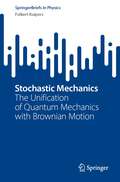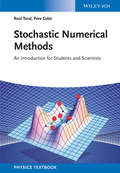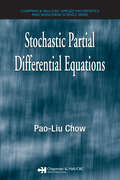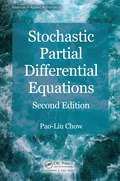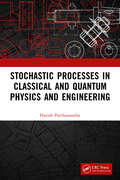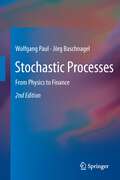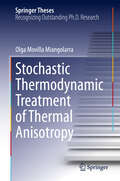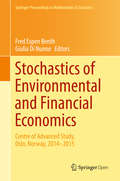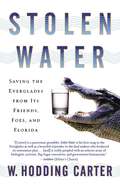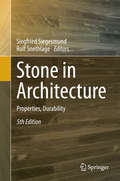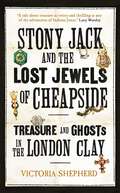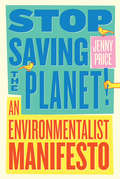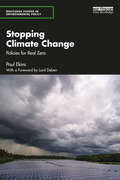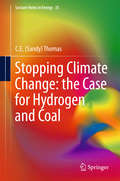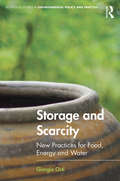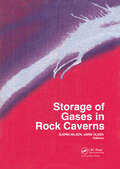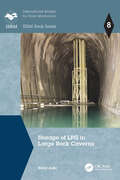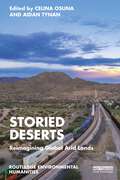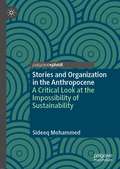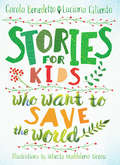- Table View
- List View
Stochastic Mechanics: The Unification of Quantum Mechanics with Brownian Motion (SpringerBriefs in Physics)
by Folkert KuipersStochastic mechanics is a theory that holds great promise in resolving the mathematical and interpretational issues encountered in the canonical and path integral formulations of quantum theories. It provides an equivalent formulation of quantum theories, but substantiates it with a mathematically rigorous stochastic interpretation by means of a stochastic quantization prescription.The book builds on recent developments in this theory, and shows that quantum mechanics can be unified with the theory of Brownian motion in a single mathematical framework. Moreover, it discusses the extension of the theory to curved spacetime using second order geometry, and the induced Itô deformations of the spacetime symmetries.The book is self-contained and provides an extensive review of stochastic mechanics of the single spinless particle. The book builds up the theory on a step by step basis. It starts, in chapter 2, with a review of the classical particle subjected to scalar and vector potentials. In chapter 3, the theory is extended to the study of a Brownian motion in any potential, by the introduction of a Gaussian noise. In chapter 4, the Gaussian noise is complexified. The result is a complex diffusion theory that contains both Brownian motion and quantum mechanics as a special limit. In chapters 5, the theory is extended to relativistic diffusion theories. In chapter 6, the theory is further generalized to the context of pseudo-Riemannian geometry. Finally, in chapter 7, some interpretational aspects of the stochastic theory are discussed in more detail. The appendices concisely review relevant notions from probability theory, stochastic processes, stochastic calculus, stochastic differential geometry and stochastic variational calculus.The book is aimed at graduate students and researchers in theoretical physics and applied mathematics with an interest in the foundations of quantum theory and Brownian motion. The book can be used as reference material for courses on and further research in stochastic mechanics, stochastic quantization, diffusion theories on curved spacetimes and quantum gravity.
Stochastic Numerical Methods
by Raúl Toral Pere ColetStochastic Numerical Methods introduces at Master level the numerical methods that use probability or stochastic concepts to analyze random processes. The book aims at being rather general and is addressed at students of natural sciences (Physics, Chemistry, Mathematics, Biology, etc.) and Engineering, but also social sciences (Economy, Sociology, etc.) where some of the techniques have been used recently to numerically simulate different agent-based models. Examples included in the book range from phase-transitions and critical phenomena, including details of data analysis (extraction of critical exponents, finite-size effects, etc.), to population dynamics, interfacial growth, chemical reactions, etc. Program listings are integrated in the discussion of numerical algorithms to facilitate their understanding. From the contents: Review of Probability Concepts Monte Carlo Integration Generation of Uniform and Non-uniform Random Numbers: Non-correlated Values Dynamical Methods Applications to Statistical Mechanics Introduction to Stochastic Processes Numerical Simulation of Ordinary and Partial Stochastic Differential Equations Introduction to Master Equations Numerical Simulations of Master Equations Hybrid Monte Carlo Generation of n-Dimensional Correlated Gaussian Variables Collective Algorithms for Spin Systems Histogram Extrapolation Multicanonical Simulations
Stochastic Partial Differential Equations
by Pao-Liu ChowAs a relatively new area in mathematics, stochastic partial differential equations (PDEs) are still at a tender age and have not yet received much attention in the mathematical community. Filling the void of an introductory text in the field, Stochastic Partial Differential Equations introduces PDEs to students familiar with basic probability theor
Stochastic Partial Differential Equations
by Pao-Liu ChowExplore Theory and Techniques to Solve Physical, Biological, and Financial Problems Since the first edition was published, there has been a surge of interest in stochastic partial differential equations (PDEs) driven by the Levy type of noise. Stochastic Partial Differential Equations, Second Edition incorporates these recent developments and impro
Stochastic Processes and Applications: SPAS2017, Västerås and Stockholm, Sweden, October 4-6, 2017 (Springer Proceedings in Mathematics & Statistics #271)
by Anatoliy Malyarenko Sergei Silvestrov Milica RančićThis book highlights the latest advances in stochastic processes, probability theory, mathematical statistics, engineering mathematics and algebraic structures, focusing on mathematical models, structures, concepts, problems and computational methods and algorithms important in modern technology, engineering and natural sciences applications.It comprises selected, high-quality, refereed contributions from various large research communities in modern stochastic processes, algebraic structures and their interplay and applications. The chapters cover both theory and applications, illustrated by numerous figures, schemes, algorithms, tables and research results to help readers understand the material and develop new mathematical methods, concepts and computing applications in the future. Presenting new methods and results, reviews of cutting-edge research, and open problems and directions for future research, the book serves as a source of inspiration for a broad spectrum of researchers and research students in probability theory and mathematical statistics, applied algebraic structures, applied mathematics and other areas of mathematics and applications of mathematics.The book is based on selected contributions presented at the International Conference on “Stochastic Processes and Algebraic Structures – From Theory Towards Applications” (SPAS2017) to mark Professor Dmitrii Silvestrov’s 70th birthday and his 50 years of fruitful service to mathematics, education and international cooperation, which was held at Mälardalen University in Västerås and Stockholm University, Sweden, in October 2017.
Stochastic Processes in Classical and Quantum Physics and Engineering
by Harish ParthasarathyThis book covers a wide range of problems involving the applications of stochastic processes, stochastic calculus, large deviation theory, group representation theory and quantum statistics to diverse fields in dynamical systems, electromagnetics, statistical signal processing, quantum information theory, quantum neural network theory, quantum filtering theory, quantum electrodynamics, quantum general relativity, string theory, problems in biology and classical and quantum fluid dynamics. The selection of the problems has been based on courses taught by the author to undergraduates and postgraduates in Electronics and Communications Engineering. Print edition not for sale in South Asia (India, Sri Lanka, Nepal, Bangladesh, Pakistan or Bhutan).
Stochastic Processes: From Physics to Finance
by Wolfgang Paul Jörg BaschnagelThis book introduces the theory of stochastic processes with applications taken from physics and finance. Fundamental concepts like the random walk or Brownian motion but also Levy-stable distributions are discussed. Applications are selected to show the interdisciplinary character of the concepts and methods. In the second edition of the book a discussion of extreme events ranging from their mathematical definition to their importance for financial crashes was included. The exposition of basic notions of probability theory and the Brownian motion problem as well as the relation between conservative diffusion processes and quantum mechanics is expanded. The second edition also enlarges the treatment of financial markets. Beyond a presentation of geometric Brownian motion and the Black-Scholes approach to option pricing as well as the econophysics analysis of the stylized facts of financial markets, an introduction to agent based modeling approaches is given.
Stochastic Thermodynamic Treatment of Thermal Anisotropy (Springer Theses)
by Olga Movilla MiangolarraThis thesis advances our understanding of how thermal anisotropy can be exploited to extract work through a mechanism that is quite distinct from the classical Carnot heat engine. Anisotropy, the presence of thermal or chemical gradients, is ubiquitous in the real world and powers the cascade of processes that sustain life. The thesis quantifies, for the first time, the maximum amount of power and efficiency that a suitable mechanism (a Brownian gyrator) can achieve in such conditions. An important contribution at the center of the thesis is to lay out a geometric framework that brings out the importance of an isoperimetric problem to analyze and quantify optimal operation of thermodynamic engines that harvest energy when simultaneously in contact with several heat baths. Fundamental bounds are derived via isoperimetric inequalities which capture the trade-off between work and dissipation that accrue during thermodynamic cycles. A geometric theory that allows such insights is explained first – the theory of optimal mass transport – followed by rudiments of stochastic thermodynamics that allow for quantification of work and entropy production during finite-time thermodynamic transitions. The thesis further explores entropy production due to heat flowing between heat baths of different temperature through the system dynamics, and concludes with analysis as a proof-of-concept of an autonomous engine that harvests energy from a thermal gradient to continuously produce work in a stable limit cycle operation.
Stochastics of Environmental and Financial Economics
by Fred Espen Benth Giulia Di NunnoThese Proceedings offer a selection of peer-reviewed research and survey papers by some of the foremost international researchers in the fields of finance, energy, stochastics and risk, who present their latest findings on topical problems. The papers cover the areas of stochastic modeling in energy and financial markets; risk management with environmental factors from a stochastic control perspective; and valuation and hedging of derivatives in markets dominated by renewables, all of which further develop the theory of stochastic analysis and mathematical finance. The papers were presented at the first conference on "Stochastics of Environmental and Financial Economics (SEFE)", being part of the activity in the SEFE research group of the Centre of Advanced Study (CAS) at the Academy of Sciences in Oslo, Norway during the 2014/2015 academic year.
Stolen Water
by W. Hodding CarterWhen the Comprehensive Everglades Restoration Plan went into effect during the Clinton administration, Florida's great grassy wilderness garnered a host of national attention -- and has since become a breeding ground for environmental dispute. What does it take to "save" a forest? How can it be preserved? Enter W. Hodding Carter. For an Outside magazine feature he's agreed to paddle the ninety-nine-mile waterway in Everglades National Park to examine the landscape from all angles -- physical, political, cultural, and very personal -- and get to the rock-bottom heart of the story. Stolen Water is the outgrowth of Carter's journey. Through investigative research, eyewitness accounts, and interviews with key players in the conservation controversy, Carter offers a rare portrait of a national treasure. Utterly important, and at times downright hilarious, Stolen Water is a classic American adventure tale, and an environmental parable for our time.
Stone in Architecture
by Rolf Snethlage Siegfried SiegesmundThe weathering of historical buildings and, indeed, of monuments and sculptures of natural stone is a problem that has been encountered for hundreds of years. However, a dramatic increase in deterioration in the structure of our built heritage has been observed during the past century. To understand the complex interaction that the stone in a building suffers with its near environment (the building) and the macro environment (the local climate and atmospheric conditions) requires an interdisciplinary approach and the application of many disciplines. Climate change over the next 100 years is likely to have a range of direct and indirect impacts on many natural and physical environments, including the built environment. The protection of our architectural heritage has both cultural and historical importance, as well as substantial economic and ecological value. Large sums of money are being spent world-wide on measures for the preservation of monuments and historical buildings. The past few decades has seen an unprecedented level of research activity in this area, the results of which are often difficult to access and are summarized in the new edition of STONE IN ARCHITECTURE.
Stonehenge - A New Understanding: Solving The Mysteries Of The Greatest Stone Age Monument
by Mike Parker Pearson“The most authoritative, important book on Stonehenge to date.”—Kirkus, starred review Stonehenge stands as an enduring link to our prehistoric ancestors, yet the secrets it has guarded for thousands of years have long eluded us. Until now, the millions of enthusiasts who flock to the iconic site have made do with mere speculation—about Stonehenge’s celestial significance, human sacrifice, and even aliens and druids. One would think that the numerous research expeditions at Stonehenge had left no stone unturned. Yet, before the Stonehenge Riverside Project—a hugely ambitious, seven-year dig by today’s top archaeologists—all previous digs combined had only investigated a fraction of the monument, and many records from those earlier expeditions are either inaccurate or incomplete. Stonehenge—A New Understanding rewrites the story. From 2003 to 2009, author Mike Parker Pearson led the Stonehenge Riverside Project, the most comprehensive excavation ever conducted around Stonehenge. The project unearthed a wealth of fresh evidence that had gone untouched since prehistory. Parker Pearson uses that evidence to present a paradigm-shifting theory of the true significance that Stonehenge held for its builders—and mines his field notes to give you a you-are-there view of the dirt, drama, and thrilling discoveries of this history-changing archaeological dig.
Stonewall's Prussian Mapmaker
by Robert K. Krick Richard Brady WilliamsPrussian-born cartographer Oscar Hinrichs was a key member of Stonewall Jackson's staff, collaborated on maps with Jedediah Hotchkiss, and worked alongside such prominent Confederate leaders as Joe Johnston, Richard H. Anderson, and Jubal Early. After being smuggled along the Rebel Secret Line in southern Maryland by John Surratt Sr., his wife Mary, and other Confederate sympathizers, Hinrichs saw action in key campaigns from the Shenandoah Valley and Antietam to Gettysburg, Petersburg, and Appomattox. After the Confederate surrender, Hinrichs was arrested alongside his friend Henry Kyd Douglas and imprisoned under suspicion of having played a role in the Booth conspiracy, though the charges were later dropped.Hinrichs's detailed wartime journals, published here for the first time, shed new light on mapmaking as a tool of war, illuminate Stonewall Jackson's notoriously superior strategic and tactical use of terrain, and offer unique perspectives on the lives of common soldiers, staff officers, and commanders in Lee's army. Impressively comprehensive, Hinrichs's writings constitute a valuable and revelatory primary source from the Civil War era.
Stony Jack and the Lost Jewels of Cheapside: Treasure and Ghosts in the London Clay
by Victoria ShepherdA thrilling history of mudlarkers, charlatans, experts and chancers – the underbelly of the Edwardian antiques trade. 'What a story! And how skilfully told! A tale about treasure, as twisty and thrilling as any of the adventures of Indiana Jones.' Lucy Worsley June 1912. A pair of workmen deposit a heavy ball of clay in the antiques shop of George Fabian Lawrence, or &‘Stony Jack&’ as he's better known. As Lawrence picks through the mud, a speck of gold catches his eye. A pearl earring tumbles into his hand, then another. A Burmese ruby follows; then Colombian emeralds, lapis lazuli from Afghanistan and turquoise from Iran; tankards; watches; topaz; amazonite. Stony Jack has discovered the greatest single cache of Elizabethan treasure. Diving into London&’s bustling, sometimes lawless, antiques trade at the turn of the century, Victoria Shepherd provides a compelling portrait of the city at the height of empire. A thrilling ride through Edwardian London, from the marble halls of the British Museum to the East End's maze of tenements and alleyways, Stony Jack and the Lost Jewels of Cheapside oversees the transformation of the city into a modern metropolis.
Stop Saving the Planet!: An Environmentalist Manifesto
by Jenny Price"Pithy, funny, exasperated, and informed…You cannot read a more important hundred pages than Stop Saving the Planet!" —Richard White, author of The Republic for Which It Stands We’ve been "saving the planet" for decades!…And environmental crises just get worse. All this hybrid driving and LEED building and carbon trading seems to accomplish little to nothing—and low-income communities continue to suffer the worst consequences. Why aren’t we cleaning up the toxic messes and rolling back climate change? And why do so many Americans hate environmentalists? Jenny Price says Enough already! with this short, fun, fierce manifesto for an environmentalism that is hugely more effective, a whole lot fairer, and infinitely less righteous. She challenges you, corporate sustainability officers, and the EPA to think and act completely anew—and to start right now—to ensure a truly habitable future.
Stopping Climate Change: Policies for Real Zero (Routledge Studies in Environmental Policy)
by Paul EkinsWritten by one of the leading experts in the field, Paul Ekins, Stopping Climate Change provides a comprehensive overview of what is required to achieve ‘real zero’ carbon dioxide emissions by 2050, and negative emissions thereafter, which is the only way to stop human- induced climate change. This will require innovation in socio-technical systems, and in human behaviour, on an unprecedented scale. Stopping Climate Change describes the changes required to meet this goal: in technologies, social institutions and individual activities. Paul Ekins examines in detail issues around the supply and demand of energy and materials, and the efficiency of their use. It also analyses greenhouse gas removal technologies, offsetting and geoengineering, and plots the reduction of the non- CO2 greenhouse gas-emitting activities. Having set out the changes required, Ekins considers the economic implications, in terms of both the innovation and investments that are necessary to bring them about, and the effects that these are likely to have on national economies. The evidence presented points clearly to the economic impacts of decarbonisation being positive for the majority of countries, and for the world as a whole, even before considering the benefits of avoided climate change. When the health benefits of stopping the burning of fossil fuels are factored in, the global net benefits of decarbonisation are unequivocal. Drawing on examples from the UK and Europe, but with wider relevance at a global scale, Stopping Climate Change clearly shows how determined policy action at different levels could stop climate change. It will be of great interest to students, scholars and policymakers researching and working in the field of climate change and energy policy.
Stopping Climate Change: Policies for Real Zero (Routledge Studies in Environmental Policy)
by Paul EkinsWritten by one of the leading experts in the field, Paul Ekins, Stopping Climate Change provides a comprehensive overview of what is required to achieve ‘real zero’ carbon dioxide emissions by 2050, and negative emissions thereafter, which is the only way to stop human- induced climate change.This will require innovation in socio-technical systems, and in human behaviour, on an unprecedented scale. Stopping Climate Change describes the changes required to meet this goal: in technologies, social institutions and individual activities. Paul Ekins examines in detail issues around the supply and demand of energy and materials, and the efficiency of their use. It also analyses greenhouse gas removal technologies, offsetting and geoengineering, and plots the reduction of the non- CO2 greenhouse gas-emitting activities. Having set out the changes required, Ekins considers the economic implications, in terms of both the innovation and investments that are necessary to bring them about, and the effects that these are likely to have on national economies. The evidence presented points clearly to the economic impacts of decarbonisation being positive for the majority of countries, and for the world as a whole, even before considering the benefits of avoided climate change. When the health benefits of stopping the burning of fossil fuels are factored in, the global net benefits of decarbonisation are unequivocal.Drawing on examples from the UK and Europe, but with wider relevance at a global scale, Stopping Climate Change clearly shows how determined policy action at different levels could stop climate change. It will be of great interest to students, scholars and policymakers researching and working in the field of climate change and energy policy.
Stopping Climate Change: the Case for Hydrogen and Coal
by C. E. Sandy ThomasThis book documents the advantages and limitations ofvarious electricity generation methods. It illustrates how both electricity andmotor fuel can be cost-effectively derived from coal, natural gas or other indigenousfuels, thereby eliminating our dependence on imported oil and the power of OPEC. It favours electricity generation systems powered exclusively by natural gas,coal, nuclear and renewables and motor vehicles powered by hydrogen(electricity from coal gasification with carbon capture and sequestration (CCS)and hydrogen as the fuel powering fuel-cell electric vehicles produced from naturalgas or by gasifying coal With CCS. ) Thebook also demonstrates that the US can meet the Climate Change goal of reducingall greenhouse gases by 80% below 1990 levels in both the transportation andelectric utility sectors using hydrogen and coal.
Storage and Scarcity: New practices for food, energy and water (Routledge Studies in Environmental Policy and Practice)
by Giorgio OstiIn an era of abundance, at least part of humanity has stopped thinking about the future provision of basic vital resources such water, energy and food. Storage actions, with all their variants whether real or imagined, are sources of innovation in the provision and treatment of crucial resources. This book deals with cases of water, food, energy and biodiversity storage as a response to a new era of scarcity. Examining multilevel storage policies, consumers’ practices and local organisations, author Giorgio Osti explores a variety of examples such as the need to stock agriculture produce, the industry and practices of food conservation, the role of artificial water basins in controlling floods and droughts and the development of batteries able to compensate for the intermittence of renewable energy sources. Storage and self-sufficiency can be achieved in many technical ways, at different territorial levels and according to different policies or philosophies. Being more a grasshopper or an ant - the two extreme positions - depends not only on the technologies available but also on different analyses of the environment and different attitudes to the future. This book offers an environmentalist perspective that uncovers hidden or absent activities of ultramodern societies that will be useful to students of environmental sociology as well as those researching and studying at the interface of environmental studies and geography.
Storage of Gases in Rock Caverns: Proceedings of the International Conference on Storage of Gases in Rock Caverns/Trondheim/26-28 June 1989
by BJØRN NILSEN; JØRN OLSENContains papers of a conference on [title] held in Trondheim, Norway, June 1989. The following storage concepts are considered: pressurized, compressed air energy, air cushion surge chambers, amonia products storage.
Storage of LPG in Large Rock Caverns (ISRM Book Series)
by Kenji AokiThis book uses actual construction projects as examples to elaborate the various technologies regarding groundwater control and air-tightness guarantees for the construction of large storage rock caverns in complicated geological conditions. It introduces the latest technologies to give hands-on experience of what to do in unexpected geological conditions, and provides insight into the design, construction and operation of underground facilities. The book is hence useful in feasibility studies, developments and other research into these underground facilities. Drawing on the experience gained from building Japan's largest LPG storage caves, Storage of LPG in Large Rock Caverns is a must-read for engineers, academics and students in the fields of rock mechanics, geotechnical engineering and related disciplines.
Storied Deserts: Reimagining Global Arid Lands (ISSN)
by Aidan Tynan Celina OsunaStoried Deserts makes a crucial and critical intervention in the field of environmental humanities by showcasing an emerging body of research on desert places from around the world.Deserts, despite dominant stereotypes of wasteland and barrenness, are culturally and ecologically abundant places. This edited volume sets out to reimagine the world’s desert places and the very concept of "the desert" itself, taking a boldly interdisciplinary and multicultural approach. Authors engage in literary ecocriticism and ecopoetics, film and visual studies, critical theory, personal and transdisciplinary reflection, creative practices, and historical scholarship. Through their diverse range of perspectives, contributors show how arid lands have been and can be understood as sites of narrative production, places where signs and imaginaries are born from the materialities of space and entanglement. In this way, this volume highlights how the storied matter of the Earth’s deserts informs lived realities, environmental histories, cinematic and literary imaginaries, political conflicts, and even intellectual categories such as "the human" and "the elemental".Ultimately, this book shows that reimagining desert places can help us to grapple with the epochal challenges of the Anthropocene. It is an important and engaging collection for scholars and students across disciplines that helps establish the value of desert humanities.
Stories and Organization in the Anthropocene: A Critical Look at the Impossibility of Sustainability
by Sideeq MohammedThis book is about the stories being told in the Anthropocene. Stories of irreparable damage being done to the global ecosystem, of sustainable growth, of dystopian collapse, of continued interspecies flourishing, of Gaia, and of accelerating capitalism’s dynamics in order to discover its outside. Stories of change. Stories of hope. Against them all, this book seeks to braid together a particular thread of storying in order to speak to the emergence of the mall at the end of the world; a space where a new politics of “spectral capitalism” is played out. In doing so, we reflect that there never was any outside to Capital, that it can live forever, its performances and spectacles being preserved despite global ecological collapse. This book seeks to understand the nascence of the mall at the end of the world and the new people, thoughts, and dreams that come with it.
Stories for Kids Who Want to Save the World
by Carola Benedetto Luciana CilientoSixteen biographies of extraordinary people--ranging from Sebastião Salgado to Björk and Greta Thunberg--who came of age fighting climate changeEvery person has a path in life, one that is intertwined with the fate of the earth. The life stories in this collection begin and end with that realization. First, as children, in different countries and eras, they witness how humans provoke environmental degradation. Each leads a life that not only minimizes their individual contribution to climate change at a local scale, but also that of their generation on a global scale. Then, as adults, they recognize the maturity and agency acquired at that moment which defined their lives. The biographies depict concrete initiatives that contribute to climate preservation, from a physicist who promotes organic farming techniques in India to a designer that only uses ecological fabrics and dyes in Italy. Rock climber Yvon Chouinard, biologist Rachel Carson, and designer Adriana Santanocito are included in this diverse cast of environmental activists. Together they show us that regardless of culture, class, or profession it is never too early or late to find your way to improve the world our children will inhabit. The stakes couldn't be higher: "Our house is on fire," as Greta Thunberg rightly said.
Stories from the Deep Earth: How Scientists Figured Out What Drives Tectonic Plates and Mountain Building
by Geoffrey F. DaviesPlate tectonics can drift continents and push up mountains, but what drives the plates? This is an insider’s account of how we answered questions posed over two centuries ago, and completed geology’s quest for a driving mechanism. Forging through confusing evidence, apparent contradictions and raging debates we arrived at not one but two mechanisms: sinking plates and rising plumes.
